|
Engineering magnetotactic bacteria to generate magnetic nanoparticles for biomedical applications
by Andy Tay
 n the 1960s, Professor Peter Paul Speiser in Switzerland devised a more effective way to deliver drugs to specific sites using nanoparticles which are tiny particles in the order of few hundred 10-9 (nano) metres. n the 1960s, Professor Peter Paul Speiser in Switzerland devised a more effective way to deliver drugs to specific sites using nanoparticles which are tiny particles in the order of few hundred 10-9 (nano) metres.
His strategy inspired biomedical researchers to exploit the small sizes (and thereof high surface area to volume ratio) of nanoparticles for a range of other applications (Fig. 1). Some of which include cancer hyperthermia where magnetic nanoparticles (MNPs) are used to convert alternating magnetic fields to heat for killing cancer cells and bio-catalysis to produce coloured or fluorescent products for disease detection using ELISA (enzyme-linked immune-sorbent assay).
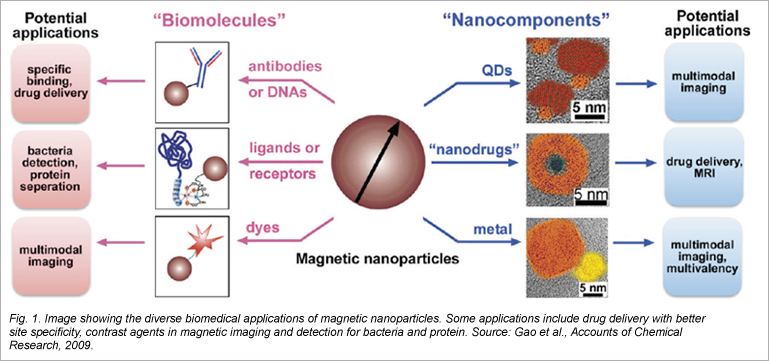
The types of nanoparticles are highly diverse and the list of literature on nanotechnology has become extremely exhaustive over the last 5 decades. For this article, I will focus only on MNPs and how we can engineer magnetotactic bacteria that over-produce high quality MNPs.
Engineering Magnetic Manoparticles with Uniform Properties
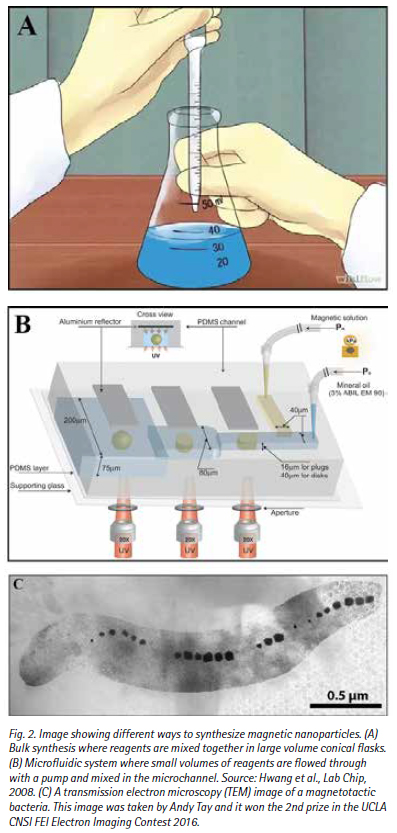
Most commercially available MNPs are currently synthesized in bulk (Fig. 2A). This means that they are made by swirling and heating different reagents in apparatus like conical flasks with huge volumes (tens to hundreds of millilitres). However, under such conditions, the physical (size and shape) and magnetic properties of MNPs are usually heterogenous due to uneven mixing and heating.
These limitations motivated researchers to design microfluidic channels where only small volumes of reagent can flow and mix at each time (Fig. 2B). The reaction time to synthesize MNPs using this method can also be programmed to enhance quality control. Most importantly, as small volumes of expensive reagents are used in microfluidic channels, it can lead to substantial cost-savings.
Unfortunately, microfluidic-based platform has its limitations. One main obstacle is that the materials of microfluidic platforms which are usually plastic polymers, degrade overtime especially when harsh chemicals that are highly acidic or alkaline are used. Consequently, it can clog or collapse microchannels, thus reducing flow stability and MNPs quality.
To overcome the limitations of batch and microfluidic methods for MNP synthesis, I turned to Nature and its magnetotactic bacteria for inspiration.
What are Magnetotactic Bacteria?
Magnetotactic bacteria (MTB) was first scientifically described in 1975 by Blakemore (Fig. 2C). Making use of a unique biomineralization process where minerals such as iron are being accumulated and crystallized, MTB produce iron-based MNPs with different shapes (spherical, bullet etc) and sizes (35–120 nm) surrounded by lipid membranes specific to their strains.
MNPs produced by MTB are reportedly superior than chemically synthesized ones as they have homogeneous sizes and crystallography, and high aqueous stability that prevents particle aggregation that many chemically-synthesized MNPs suffer from. In addition, as they are surrounded by lipid membranes, simple chemistry techniques can be performed to functionalize biopolymers like starch onto the MNPs to increase their biocompatibility for use in biomedical applications.
These advantageous properties have encouraged microbiologists to genetically engineer MTB mutants that over-produce MNPs. Various research groups made use of targeted gene editing to create MTB mutants that more MNPs. However, none of the reported mutants generated MNPs with uniform magnetic properties.
Another challenge of using MTB as a source of MNPs is that they are fastidious prokaryotes that grow slowly even with optimized culture conditions. As a comparison, MTB doubling time is 4-6 hrs while it takes Escherichia coli only 20 min for one cell division. Kolinko et al. attempted to address the growth limitation by transferring 30 key genes from a MTB strain known as Magnetospirillum (M.) gryphiswaldense to Rhodospirillum (R.) rubrum, a faster growing prokaryote. While the engineered R. rubrum did produce MNPs, they had heterogenous physical and magnetic properties, and were not useful for biomedical applications that require manufacturing consistencies.
Our Solution: Phenotypic Selection-driven Evolution of MTB Over-producers
As a PhD student in the University of California, Los Angeles, I capitalized on the idea of directed evolution to generate MTB over-producers without any growth deficiencies. In this approach, I randomly mutate MTB and select the over-producers over multiple mutation-selection cycles.
Unfortunately, the available tools for selecting MTB with different magnetic contents are limited. The current methods for selection are electron microscopy, which allow researchers to count the number of MNPs in each bacterium. The other technique is color inspection of colonies i.e. the darker the bacterial colonies on agar plate, the more dark-looking iron MNPs they produced. In general, these tools are slow, laborious, non-quantitative and subject to users’ biases.
Magnetic Microfluidic Platform
To proceed with phenotypic selection, I developed a magnetic microfluidic system (Fig. 3A) that facilitates quantitative and high throughput enrichment of MTB over-producers. The magnetic microfluidic device consists of two inlets: the top inlet for introducing media and the bottom inlet for MTB suspension. It also has two outlets i.e. selection (top) and waste (bottom). A magnet is placed adjacent to the microchannel to generate a local magnetic field.
MTB flow into the microfluidic channel through the bottom inlet and experience different magnitudes of magnetic forces based on their magnetic contents i.e. how many MNPs they have. They experience an upward force due to the magnet and a resisting downward force known as Stokes’ drag due to fluid friction. My goal is to attract the MTB over-producers across the fluid streams from the bottom half of the microchannel to the selection outlet.
How Does it Work?
When MTB are attracted by magnetic forces, they start to move upwards. As they speed up, the Stokes’ drag they experience also increase proportionally with their velocities. At the point when magnetic force and Stokes’ drag balance, the MTB experience what is known as terminal velocity. Under this state, the MTB move with constant upward velocities (refer to glossary for mathematical proof).
There is, however, a catch!
This is because through random mutations, we first generated MTB that over-produce MNPs. These over-producers with larger number of MNPs experience stronger magnetic forces. Consequently, they have more time for acceleration, allowing them to attain larger terminal velocities. This means that they need less time to cross the fluid streams before they are being flowed into the waste outlet by the pump.
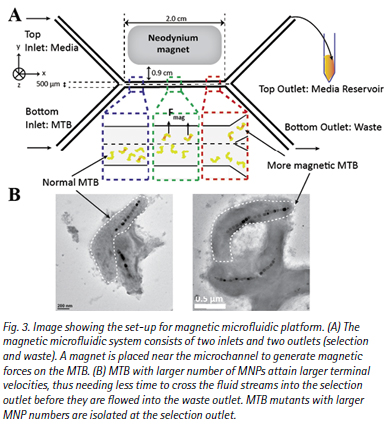
By tuning the conditions for flow and magnetic field strengths, I optimized phenotypic selection of MTB over-producers such that only MTB above a certain cut-off number of MNP are isolated at the selection outlet (Fig. 3B).
Validating the Isolation Efficiency of Magnetic Microfluidic Platform
When this technology was developed, I initiated collaboration with the Schüler group in the University of Bayreuth to validate the utility of our system. This project was supported with a grant from the Bavaria California Technology Centre.
With the Schüler group, we generated four types of mutants. They were wild-type (WT) and ∆mamAB MTB (this mutant cannot produce any MNPs as the genes mamAB that encodes for MNPs are knocked out) which were either produced green (GFP) or red (mCherry) fluorescent proteins. This meant that with optical imaging, we could then distinguish the fluorescent MTB.
I first showed that WT MTB can be isolated at the selection outlet with 71% (WT-GFP) and 80% (WT-mCherry) efficiency while ∆mamAB MTB which do not have MNPs were largely absent from the selection outlet (Fig. 4A).
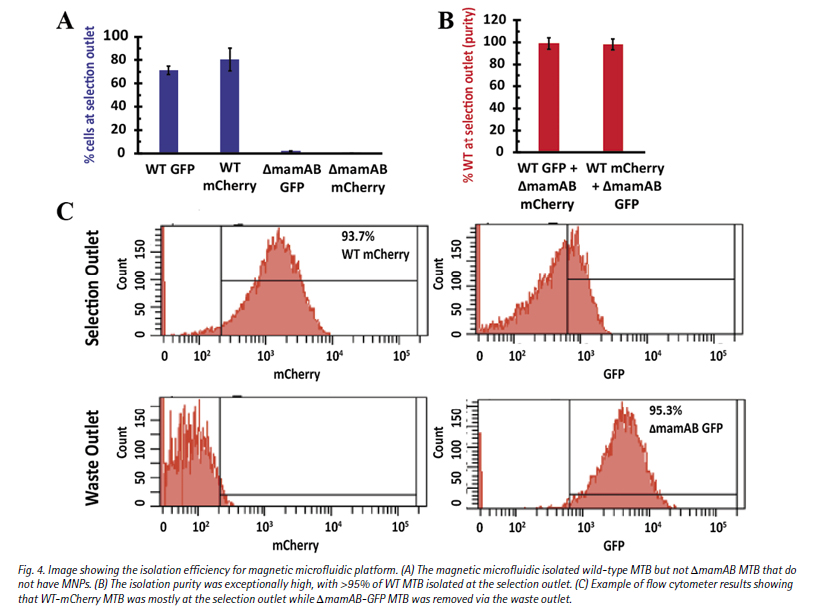
Next, I mixed equal numbers of WT-GFP with ∆mamAB-mCherry and WT-mCherry with ∆mamAB-GFP, and performed separation using our magnetic microfluidic technology. I achieved an isolation purity as high as 95% of the WT populations isolated at the selection outlet (Fig. 4B). Fig. 4C shows the flow cytometry results when WT-mCherry was mixed with ∆mamAB-GFP. The population at the selection outlet had 93.7% of WT-mCherry MTB while the waste outlet had 95.3% of ∆mamAB-GFP MTB.
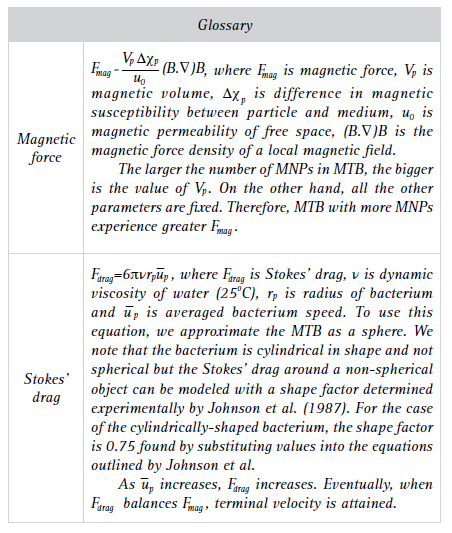
Conclusions
MNPs have diverse biomedical application but for them to be useful, they need to possess uniform physical and magnetic properties. Bulk synthesis may allow high throughput production but this method often compromises the MNP quality. On the other hand, microfluidic MNP synthesis facilitates greater control of MNP properties but this technique might not be compatible with certain reagents used for MNP fabrication.
Nature has inspired us to look at how MTB produce high quality MNPs with highly homogenous physical and magnetic properties. Through multiple cycles of random mutation and magnetic selection, I have generated MTB over-producers without any growth deficits. The next step is to perform genome sequencing to identify key genes for us to better engineer the genome of MTB and even other prokaryotes for cheap, large-scale and high-quality bio-manufacturing of MNPs.
Andy Tay is a National University of Singapore Overseas Graduate Scholarship and Overseas Postdoctoral Fellowship recipient. He recently completed his PhD at the University of California, Los Angeles and will be heading to Stanford University for his postdoctoral training. Andy’s research interest lies in magnetic biomedicine including magnetic neural stimulation and magnetotactic bacteria. Andy also enjoys science communication, traveling and using the gym. He can be contacted at bietkpa@nus.edu.sg.
 Click here to download the full issue for USD 6.50 Click here to download the full issue for USD 6.50
|


 n the 1960s, Professor Peter Paul Speiser in Switzerland devised a more effective way to deliver drugs to specific sites using nanoparticles which are tiny particles in the order of few hundred 10-9 (nano) metres.
n the 1960s, Professor Peter Paul Speiser in Switzerland devised a more effective way to deliver drugs to specific sites using nanoparticles which are tiny particles in the order of few hundred 10-9 (nano) metres.





 Click here to download the full issue for USD 6.50
Click here to download the full issue for USD 6.50